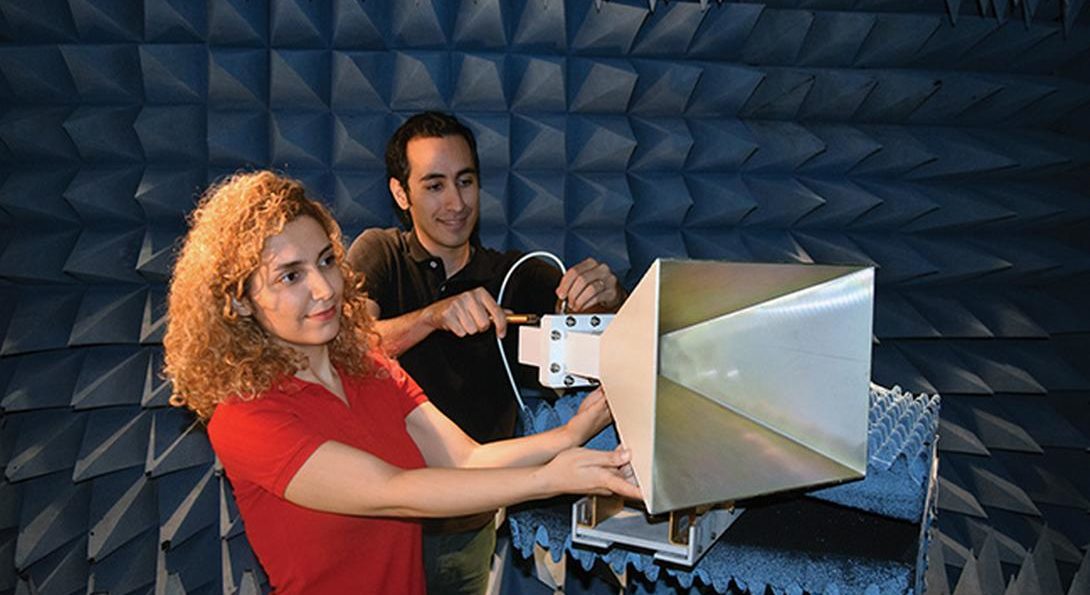Prolific pair awarded scholarships from IEEE Electromagnetic Compatibility Society

Two prolific ECE students were recently awarded scholarships from the Chicago Chapter of the IEEE Electromagnetic Compatibility Society. Seiran Khaledian, a second year Ph.D. student, was awarded $1,000 and Farhad Farzami, a third year Ph.D. student, received $500 for their achievements in research.
“Ms. Khaledian is a very bright student, who is making very good progress in her research with a lot of potential for success,” said ECE Professor Danilo Erricolo, who is the director of the Andrew Electromagnetics Laboratory at UIC. “On an academic level, I know that she is an excellent student because she has taken two courses with me and she received an A grade in both of them.”
“Ms. Khaledian has a very dedicated and sincere approach towards her research,” added ECE Associate Professor Besma Smida, who is Khaledian’s advisor. “This enabled her in a short span of one year to publish one conference paper and submit three journal papers: IEEE Transaction on Communications, IEEE Microwave and Wireless Components Letters, and IEEE Antennas and Wireless Propagation Letters.”
She has been making very good progress and has co-authored five publications during her tenure at UIC. In addition, she is part of a team working on a new journal paper. Her research activity is focused on self-interference cancellation, which is a very important and timely topic for applications in wireless communication systems.
“In fact, the existence of self-interference causes a reduction of the performance of full-duplex and half-duplex wireless communication systems,” said Erricolo, who is an IEEE Fellow and Editor-in-Chief of the IEEE Transactions on Antennas and Propagation journal. “There are a lot of studies related to the reduction of self-interference using digital techniques. However, what distinguishes the research of Ms. Khaledian is that she is interested in an analog approach at the level of the RF front-end and the antenna. In fact, an approach that includes an analog component is needed to achieve the levels of self-interference, which are required for the applications she is considering.”
Farzami has been working on the design of reconfigurable dual-band reflection amplifiers. He has co-authored four journal articles in IEEE publications, one in an Elsevier publication, and 14 conference presentations.
“He is a very brilliant student, he is a very hard working person, and he is making very good progress in his research activities,” said Erricolo. “He is also a very likeable person.”
According to the professor, the graduate student’s research activity focuses on the design of components for self-interference cancellation for full-duplex communication systems. The importance of full-duplex communication systems is that they use the same frequency band for both transmitting and receiving, which is an improvement over ordinary communication systems where two different frequency bands are used. As a result, full-duplex system have the potential to double the capacity of the communication channel and make better usage of the available frequency spectrum. However, there is a major electromagnetic compatibility challenge to address in the realization of a full-duplex system: the cancellation of the strong self-interference of the transmitted signal on the received one.
“Mr. Farzami is an excellent student, as I have directly observed in two courses that he took with me,” said Erricolo. “He is a straight “A” student with a perfect 4.0/4.0 GPA. As a teaching assistant, he helped me create a laboratory manual for [the department’s] technical elective course on RF and Microwave Guided Propagation (ECE 424), and next summer we are planning to prepare a new laboratory for the technical-elective course on Electromagnetic Compatibility (ECE 423).”
The IEEE Electromagnetic Compatibility Society is the world’s largest organization dedicated to the development and distribution of information, tools and techniques for reducing electromagnetic interference. The society’s field of interest includes standards, measurement techniques and test procedures, instrumentation, equipment and systems characteristics, interference control techniques and components, education, computational analysis, and spectrum management, along with scientific, technical, industrial, professional or other activities that contribute to this field.